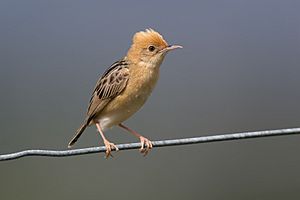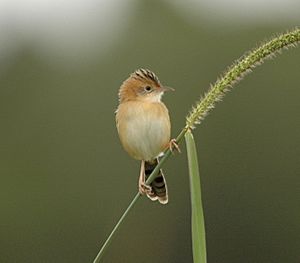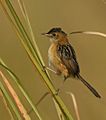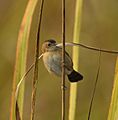Bright-capped cisticola facts for kids
Quick facts for kids Golden-headed cisticola |
|
|---|---|
 |
|
| Adult male during the breeding season | |
| Conservation status | |
| Scientific classification | |
| Synonyms | |
|
The golden-headed cisticola (Cisticola exilis), also called the bright-capped cisticola, is a small bird. It belongs to the warbler family, Cisticolidae. You can find it in Australia and many countries in Asia.
This bird is usually brown and cream. But during the mating season, it changes! Males become golden with a much shorter tail. It eats both plants and insects. This bird is famous for its amazing nest-building skills, earning it the nickname "finest tailor of all birds." It builds nests using plants and spider threads. The golden-headed cisticola has a very large population that is growing.
Contents
About the Golden-headed Cisticola
The golden-headed cisticola is a small bird. It grows to be about 9 to 11.5 centimeters (3.5 to 4.5 inches) long. It weighs between 6 and 10 grams (0.2 to 0.35 ounces). Males are a little heavier than females.
What Does it Look Like?
During the breeding season, male golden-headed cisticolas look very special. Their bodies turn golden, and their heads become golden-orange. They also have a shorter tail. This shorter tail might help them find a mate.
Outside of the breeding season, males and females look similar. They have a cream-colored belly and a brown back. Their upper bodies have black or dark brown stripes. Their wings are black, and their heads are golden. Their throat is white, and the back of their neck is a dull gold. Young birds look like adults but are lighter in color. When the bird sings, it raises a small crest on its head!
What Does it Eat and Do?
The golden-headed cisticola is an omnivore. This means it eats both plants and animals. It mainly eats small bugs like insects and slugs. It also enjoys grass seeds.
Finding Food and Moving Around
This bird usually looks for food on the ground. It hides among plants like tall grass to sneak up on its prey. It moves slowly while searching. Most of the time, these birds stay in one place their whole lives. But sometimes, if their home changes, they might move to a new spot. Some golden-headed cisticolas have been seen traveling in New Guinea and Tasmania. They might even move to different areas in China during certain times of the year.
Bird Calls
The golden-headed cisticola makes many different sounds. These sounds are unique and help tell it apart from other birds. Some people describe its calls as a "teewip" or a "wheezz, whit-whit." You usually find these birds alone or in small groups. Outside of the breeding season, they can sometimes form larger groups.
How Golden-headed Cisticolas Breed
Golden-headed cisticolas usually mate during the rainy season. The exact time of year depends on where they live. For example, in China, they breed from May to July. In Australia, they can breed almost any time of year if there's enough rain.
Building a Home
These birds build their nests in bushes, tall grass, and other plants. They usually build them no more than 3 meters (10 feet) off the ground. The nests are made from green leaves, soft plant fluff, and grass. The green leaves help the nest blend in and stay hidden.
The golden-headed cisticola is known as the "finest tailor of all birds." This is because it stitches its nest together using spider web threads! It makes small holes in the leaves, threads spider silk through them, and then pulls the nest together. Both the male and female help build the nest. The female does the stitching, and the male brings her spider web threads. The nests are round with an opening on the side.
Eggs and Chicks
Females usually lay three to four eggs at a time. The female sits on the eggs to keep them warm for about 11 days until they hatch. About 32% of the eggs successfully hatch. After the chicks are born, the female feeds them. The male protects the nest, chasing away any animals that come too close. The young birds stay in the nest for 11 to 13 days.
Where Do They Live?
The golden-headed cisticola lives in a very large area and has a huge population. You can find it in Australia, Cambodia, China, India, Indonesia, Myanmar, Nepal, Papua New Guinea, the Philippines, Taiwan, Thailand, Timor-Leste, and Vietnam. It is the most common type of cisticola bird in Australia and from India to the Philippines.
Experts believe that the number of golden-headed cisticolas is growing around the world. In most places, you might find about 2 to 6 birds in one hectare (about 2.5 acres). But in some areas, like Kimberley in Western Australia, there can be as many as 27 birds in a hectare! Because there are so many of them and their population is increasing, the International Union for Conservation of Nature (IUCN) lists them as a species of "least concern." This means they are not currently at risk of disappearing.
Their Homes
These birds like to live in places with tall, thick grass. This includes grassy hills, savannas (grasslands with scattered trees), woodlands, scrublands, rivers, wetlands, or even farmed areas that are watered. When it's not breeding season, they mostly prefer to stay close to the ground. In Northern Australia, where grasslands can have fires, they sometimes live at the edges of forests. They usually live at altitudes of 1,200 meters (about 3,900 feet) or less. However, in China, they can live up to 1,500 meters (about 4,900 feet), and on the island of Lombok, up to 1,800 meters (about 5,900 feet).
Images for kids
See also
 In Spanish: Cistícola cabecidorado para niños
In Spanish: Cistícola cabecidorado para niños






